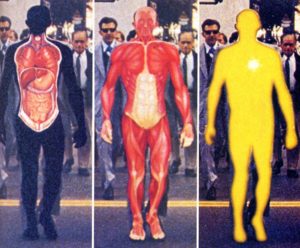The textbooks are missing a chapter.

Visible Man I remember my friends and I played for hours, taking him apart and piecing him back together. In the process we were learning about our own bodies the heart, lungs, brain, muscles, veins, arteries, and the rest. But we never asked ourselves, "Which part is it that makes the body alive?"
In biology and chemistry classes our teachers told us that a complex arrangement of atoms is all it takes to make a living human being complete with a unique personality, emotions, opinions, and intelligence. But the atoms in our bodies are the same as the atoms in automobiles, TV sets, cameras, and other nonliving objects. So what makes one complex arrangement of atoms living and another nonliving?
I never got a straight answer to that question until I read ancient India's classic Bhagavad-gita. "Besides the material elements there is a superior element, which is the life force, or soul, in all beings." (Bhagavad-gita 7.5)
The soul is infinitesimal-smaller than an atom. So the soul eludes, electron microscopes, what to speak of probing scalpels. But that doesn't make the soul's existence any less real. The mind is invisible, too, but we know it's there by its symptoms. In the same way, we can know that the soul is present in the body by the' symptom of consciousness.
"As the sun alone illuminates all the universe," says Bhagavad-gita, "so does the soul, one within the body, illuminate the entire body by consciousness," (Bg. 13.34)
As sunlight points to the presence of the sun, consciousness points to the presence of the soul. Bhagavad-gita tells us that the soul sits in the heart of every being. And even modern medical science admits that the heart is the seat of all the body's energies.
Actually, red corpuscles in the circulatory system carry consciousness from the soul all over the body. If the circulation to any part of the body is blocked, we experience a localized loss of consciousness for instance, our leg "falls asleep." And where the blood doesn't flow at all, as in our hair and nails, there's no consciousness.
If it actually is the soul in the heart that gives life and consciousness to the body, then what happens to the soul if the heart is transplanted? Srila Prabhupada, my spiritual master, gave this analogy: "If I'm sitting in your home in an old chair, you may bring a nicer one to make me more comfortable. While you replace the old chair with the new one, I'll get up and stand aside, and then I'll sit down again in the new chair. Similarly, before a surgeon removes a patient's heart, the soul moves to a different part of the body. Then, after another heart has been inserted, the soul returns and takes his seat in the new heart. But in any case, with this heart or that one, as soon as the soul leaves the body, all that's left is a corpse.

In other words, the body is dead matter that appears alive, as long as the soul is in it. Without the soul there's no life, just as without the sun there's no sunlight.
We won't find the soul listed in the Periodic Table of Elements. Nor can we perceive him with our blunt material senses. But we can learn of his qualities from Bhagavad-gita:
"That which pervades the entire body is indestructible. No one is able to destroy the imperishable soul. The soul can neither be cut into pieces by any weapon, nor can he be burned by fire, nor moistened by water, nor withered by the wind. This individual soul is unbreakable and insoluble and can be neither burned nor dried. Know that he who dwells in the body is eternal and can never be slain." (Bg. 2.17, 23-25, 30)
Today many children are playing with Visible Man kits. Many students are studying biology and anatomy. But the kit has a missing piece, the textbooks a missing chapter. No one knows the soul. Some think the soul is just religious sentimentalism. Others are too busy to take interest. Still others may have some interest, but don't have a clear, scientific conception of the soul and the soul's relationship to the body. Yet although ignored, scorned, and misunderstood, the invisible living force-the soul-is the most important part of the body. Understanding the soul and his spiritual activities is the beginning of self-realization, the beginning of real life.
